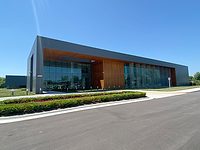I recently attended the grand opening of WACKER's new Silicones R&D Center in Ann Arbor, Michigan. The facility is dedicated to support the company’s overall business and product development in North America.
The new Silicones R&D Center is located at the co-work campus of the Michigan Innovation Headquarters (MI-HQ) in Ann Arbor, a 90,000-square-foot building that houses more than 20 companies. The MI-HQ serves as a sort of incubator for ideas between companies. WACKER’s portion of the building includes a 10,000-square-foot lab facility for R&D and analytics, and offers a state-of-the-art lab environment for the development of new products dedicated to customers in the Americas.
At the facility opening, David Wilhoit, Wacker Chemical Corporation President and CEO, noted that the company is investing in R&D in the U.S. region because it is confident in the business climate. “This is a strong step to prepare us for the future growth that is expected,” he said. He also pointed out the major significance of the new R&D center for WACKER. “We have completed the necessary preparation work and installation of equipment for several labs focusing on research and development. Right from the start we are engaged in projects involving health and medical care, paints and coatings, electronics and personal care products, all of which are key industry growth segments, particularly for silicone-based chemistry,” Wilhoit explained.
According to Axel Schmidt, Wacker Chemical Corporation Vice President, Silicones Division, the company expects to see 3-5% growth for silicones over the next 10 years. Trends that support this growth are living comfort, urbanization and resource savings. Schmidt stated that locating the Silicones R&D Center in Ann Arbor complements WACKER’s strategic business model of being close to customers and close to serving regional market trends.
“Our silicone research at the Ann Arbor R&D Center will be focused on developing advanced and forward-looking solutions in concert with regional trends that can be quickly brought to market. And importantly,” Schmidt emphasized, “our team of highly specialized R&D experts in the field of silicone and polymer chemistry will be offering customers long-term technical assistance in support of WACKER’s future business growth.”
WACKER chose Ann Arbor for a variety of reasons. First, as a technology hub and the location of the University of Michigan, the city provides a highly skilled talent pool. Ann Arbor has also recently received several high national rankings, including the number-one best city to live in the United States (niche.com), and the number-one most educated city in the United States (WalletHub). It has also been ranked as the number-one employment destination, and the sixth best city for entrepreneurs. All of these are desirable qualities when seeking talented new employees to move to your city. In fact, the facility’s first 10 employees are men and woman from nine different countries, with backgrounds in material science, organometallic chemistry, analytical chemistry, organic chemistry, polymer science and engineering, and bio-organic chemistry. This year WACKER will hire two more scientists for this facility, and has room for 25 total employees. Ann Arbor is also close to the company’s Adrian, Michigan, silicones plant, which will produce the products that are conceptualized and developed in Ann Arbor.
Dr. John Young gave attendees a tour of the new facility, noting that the chemists that work there created and designed the space. The R&D facility features two labs, one that focuses on synthesis, and the other on formulating, as well as an analytical room to monitor and test products that are developed. The common lunch area in the building is shared by all of the MI-HQ occupants, and Young noted that many conversations about science and innovation take place here, as well as requests to try each other’s products in their own developments.
The facility began operating in April of this year, and at the grand opening in mid-June, already had six projects currently running. The scientists would not elaborate on what they were working on, but stated that they are local, North American projects that are focusing on growth fields.








Report Abusive Comment